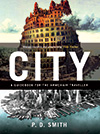08 December 2007 | Hitchens, Reviewing, scientists |
I've been reading a fascinating study of microbes - Deadly Companions by Dorothy H. Crawford, just published by OUP. Her book shows how bacteria, viruses and other microscopic organisms have proven themselves to be masters of evolution, deftly exploiting any opportunity created by our changing lifestyles.

Our bodies are teeming with microbes - 1014 to be exact; that's about a kilogram in weight. Astonishingly, they outnumber our own body cells by 10 to 1. According to Crawford: "We relative newcomers to the planet emerge from the safe environment of our mother's womb pristine, untouched by the infectious microbes, but within hours our bodies are colonised by swarms of them, all intent on living off this new food source."
But, happily, they're not all bad: at least 400 of them help our bodies ward off other, deadly microbes. Of the million or so microbes known to science, only 1,415 cause human diseases. Of course, they don't mean to harm us; our diseases are just side-effects of their life-cycles. But ever since Homo sapiens evolved, we have been locked in mortal combat with microbes, our deadly companions. In fact, Crawford argues they have shaped our history as a species.
You can read my review of Crawford's excellent book in today's Guardian Review. In the same issue I've also reviewed The Portable Atheist: Essential Readings for the Nonbeliever, a wonderful anthology selected by Christopher Hitchens, and Bad Medicine: Doctors Doing Harm since Hippocrates, by David Wootton, a controversial view of the history of medicine. Both ideal Christmas stocking-fillers! You can read my reviews of these here.
06 December 2007 | atomic bomb, Bryson, Doomsday Men, Eco, London, Penguin, Rutherford, scientists, Szilard, Wells |
Next week Doomsday Men is released in the United States, but it is still being reviewed here in the UK, six months after it was published. I've just seen a review which appeared in the Church Times on 23 November by the Revd Dr Gavin Ashenden, who is a chaplain and lecturer at the University of Sussex. I'm glad to say he enjoyed the book! Unfortunately the review is not available online (unless you are a subscriber) but here are some excerpts:
"Nuclear weapons, alchemy, aspirations of the scientific ethical good becoming 'nightmares' of total destruction, scientific prophecies - this is the story of the nuclear bomb. The narrative is gripping and morally astute. [...] The science is told with a Bill Brysonish kind of panache. But, at times, it becomes a cross between Bryson and Umberto Eco. There is a sub-narrative of esoteric knowledge and mysterious, astonishingly accurate predictions from HG Wells. Learned, accessible, and drawing occasionally on the stylistic skills of the novelist, this makes for a very good read."
Ashenden clearly enjoyed the anecdotes about Leo Szilard, one of the founding fathers of the atomic age and a central figure in the book:
"The narrative contains wonderful details. Leo Szilard spent his mornings 'thinking' in the public bath of the Strand Palace Hotel. At noon he would be ejected by the maid. There, he conceived of the relationship between uranium and the requisite nuclear chain reaction. When he took his discovery to Ernest Rutherford in 1934, he was thrown out of his office. Szilard was enormously grateful retrospectively. Had his discovery entered the public scientific domain earlier than it did, Hitler would have got his hands on the bomb some time before 1945."
The Strand Palace Hotel is in fact just across the road from the offices of my UK publisher, Penguin. Now there's a coincidence for you!
17 November 2007 | Brzezinski, cold war, iron curtain, Khrushchev, Korolev, Reviewing, USSR, Wright |
I've just reviewed two excellent Cold War histories for the Guardian: Red Moon Rising: Sputnik and the Rivalries that Ignited the Space Age, by Matthew Brzezinski, and Iron Curtain: From Stage to Cold War, by Patrick Wright.
Here's the first paragraph:
"On February 27 1956, Khrushchev and members of the Supreme Soviet Presidium (as the Politburo was then known) left Moscow in a convoy of official limousines bound for NII-88, the USSR's top-secret rocket research laboratory. They were on their way to meet a man whose work was so secret his name had been erased from all records. Officially referred to as the chief designer, the man in charge of the Soviet missile programme would only be named after his death: Sergei Korolev."
They are very different books: Red Moon Rising is popular in style, with a compelling narrative. Iron Curtain is a richly researched and highly original history that reveals the origins of that key Cold War metaphor - the Iron Curtain. Both are well worth reading and I recommend them.
You can read the rest of the review on the Guardian's site, here.
16 November 2007 | Atomic Age, Doomsday Men, Dr Strangelove, terrorism, Trident, WMD, Zuckerman |
There was a chilling report on Newsnight yesterday. Their Science Editor, Susan Watts, has found out that until the early days of the Blair government the RAF's nuclear bombs were armed by turning a bicycle lock key.

It sounds scarcely believable but it's true - as I found out writing Doomsday Men, truth is often stranger than fiction. Forget about all the sophisticated electronic fail-safe locks you see in Hollywood movies preventing someone from detonating a nuclear bomb. Until 1998 the UK's nukes could be armed with a small metal key. So if one had fallen into the hands of terrorists there were no safeguards - a combination lock, for instance - to prevent them from detonating it.
Equally disturbing is the fact that Newsnight has discovered that UK submarine commanders have the ability to launch their nuclear missiles without authorization from the British Prime Minister. France and the United States introduced a fail-safe system of release codes to prevent a general from starting World War III, as happens in Dr Strangelove.
According to Newsnight, as early as 1966 an attempt was made to introduce such safeguards for British nuclear weapons. The Chief Scientific Adviser, Solly Zuckerman, told the Defence Secretary, Denis Healey: "the Government will need to be certain that any weapons deployed are under some form of 'ironclad' control".
But secret documents from the time reveal that the Royal Navy prevented this from happening. They argued that officers of the Royal Navy could be trusted with these ultimate weapons of mass destruction: "It would be invidious to suggest... that Senior Service officers may, in difficult circumstances, act in defiance of their clear orders".
Given that the UK plans to spend some £20 billion updating its Trident submarine missile system, maybe our government should also think about introducing some twenty-first century safeguards to protect us all from the misuse of these terrible weapons.
You can read a summary of Newsnight's findings and watch part of Watts' report here.
14 November 2007 | Doomsday Men, Haber, WMD, WW1, WW2 |
The Australian Literary Review has published a review of Doomsday Men. It's by Richard King and is well worth reading. Here's an extract:
"...for those with the time and inclination to get their heads around nuclear physics, with its dizzying intermingling of the massive and the infinitesimal, then P. D. Smith’s Doomsday Men is as good a place to start as any. Despite its rather titillating title and the schlock-horror gaudiness of its fifties-style cover, Smith’s is a hugely interesting history of some hugely difficult subject matter, in which the alchemy of nuclear fission and fusion is merely part of a wider story stretching back to the nineteenth century... Smith is no less fascinating on the pre-history of weapons of mass destruction, from the chemical weapons of the First World War, to Japan’s experiments with biological weaponry, to the bombing of German and Japanese cities (the accounts of which are scarcely less harrowing than the accounts of the effects of the atom bomb)."
You can read the rest on the author's blog here.



